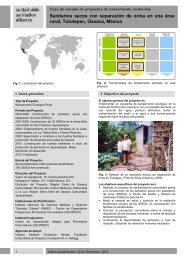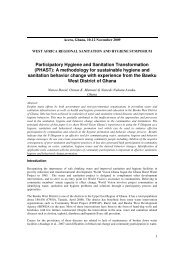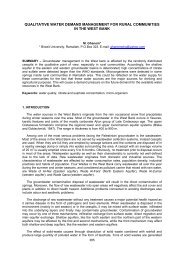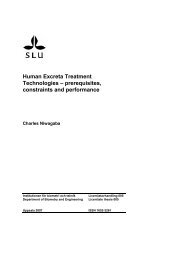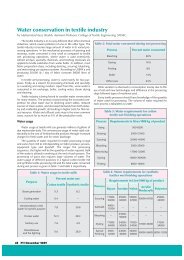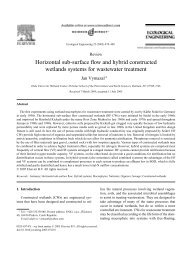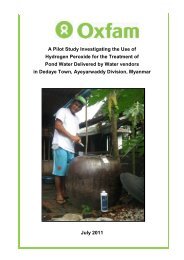Compilation of 13 factsheets on key sustainable sanitation ... - SSWM
Compilation of 13 factsheets on key sustainable sanitation ... - SSWM
Compilation of 13 factsheets on key sustainable sanitation ... - SSWM
You also want an ePaper? Increase the reach of your titles
YUMPU automatically turns print PDFs into web optimized ePapers that Google loves.
1 Summary<br />
This factsheet deals with the planning <str<strong>on</strong>g>of</str<strong>on</strong>g> <strong>sustainable</strong><br />
sanitati<strong>on</strong> for urban and peri-urban areas <str<strong>on</strong>g>of</str<strong>on</strong>g> developing<br />
countries and its importance for achieving comprehensive<br />
and inclusive sanitati<strong>on</strong> coverage in cities.<br />
The <strong>key</strong> messages <str<strong>on</strong>g>of</str<strong>on</strong>g> this factsheet are:<br />
• Top-down, supply-driven planning c<strong>on</strong>tinues to dominate<br />
much <str<strong>on</strong>g>of</str<strong>on</strong>g> sectoral planning in the developing world. The<br />
resulting capital-intensive soluti<strong>on</strong>s tend to be costly,<br />
energy-intensive and inflexible, and <str<strong>on</strong>g>of</str<strong>on</strong>g>ten fail to reach<br />
large proporti<strong>on</strong>s <str<strong>on</strong>g>of</str<strong>on</strong>g> the urban poor.<br />
• Experience has shown that importing sanitati<strong>on</strong> planning<br />
models from industrialised countries and implementing<br />
centralised “<strong>on</strong>e-size-fits-all” soluti<strong>on</strong>s is in many cases<br />
inappropriate and not <strong>sustainable</strong> in developing<br />
•<br />
countries. Thus, planning approaches must be adapted<br />
to better allow for the planning and implementati<strong>on</strong> <str<strong>on</strong>g>of</str<strong>on</strong>g><br />
c<strong>on</strong>text-specific sanitati<strong>on</strong> systems.<br />
Recent innovati<strong>on</strong>s in sanitati<strong>on</strong> planning include a more<br />
integrated planning approach; a greater emphasis <strong>on</strong><br />
the actual needs and financial capacity <str<strong>on</strong>g>of</str<strong>on</strong>g> the users,<br />
encompassing close c<strong>on</strong>sultati<strong>on</strong> with all stakeholders 1<br />
and a systems approach to sanitati<strong>on</strong>, integrating all<br />
domains <str<strong>on</strong>g>of</str<strong>on</strong>g> the city.<br />
• There is a lack <str<strong>on</strong>g>of</str<strong>on</strong>g> integrati<strong>on</strong> between the various<br />
2<br />
comp<strong>on</strong>ents <str<strong>on</strong>g>of</str<strong>on</strong>g> envir<strong>on</strong>mental sanitati<strong>on</strong> – excreta,<br />
domestic and industrial wastewater, solid waste and<br />
storm water are managed in separate systems, which<br />
are <str<strong>on</strong>g>of</str<strong>on</strong>g>ten run by different agencies or instituti<strong>on</strong>s. Better<br />
use <str<strong>on</strong>g>of</str<strong>on</strong>g> generated synergies through integrated<br />
•<br />
approaches could lead to more <strong>sustainable</strong> and costeffective<br />
soluti<strong>on</strong>s.<br />
Political ec<strong>on</strong>omy issues: improving sanitati<strong>on</strong> coverage<br />
especially for the urban poor means tackling vested<br />
interests and corrupt practices <str<strong>on</strong>g>of</str<strong>on</strong>g> regulatory authorities,<br />
the private sector and politicians. Planning must openly<br />
deal with these issues and seek to increase incentives<br />
for anti-corrupt behaviours and to achieve greater<br />
transparency at community and city levels.<br />
• Local authorities, utilities and d<strong>on</strong>ors have to be<br />
c<strong>on</strong>vinced that commitment and effective participati<strong>on</strong><br />
1 Stakeholders in the sanitati<strong>on</strong> sector are households, local and<br />
nati<strong>on</strong>al authorities, community-based organisati<strong>on</strong>s, community<br />
leaders, utilities, private service providers, NGOs and farmers.<br />
2 Envir<strong>on</strong>mental sanitati<strong>on</strong> includes sanitati<strong>on</strong>, stormwater drainage<br />
and solid waste management. Water supply is also addressed in so<br />
far as it impacts <strong>on</strong> the above envir<strong>on</strong>mental sanitati<strong>on</strong> services.<br />
SuSanA factsheet<br />
Planning <str<strong>on</strong>g>of</str<strong>on</strong>g><br />
<strong>sustainable</strong> sanitati<strong>on</strong><br />
for cities<br />
April 2012<br />
from all stakeholders are needed to achieve adequate<br />
and inclusive sanitati<strong>on</strong> services.<br />
This factsheet elaborates <strong>on</strong> the shortcomings <str<strong>on</strong>g>of</str<strong>on</strong>g> supplydriven<br />
planning and presents three demand-led approaches<br />
which recognise that stakeholder involvement is a<br />
prerequisite to effective planning. Based <strong>on</strong> past experiences<br />
we propose guiding principles for better sanitati<strong>on</strong> planning<br />
in cities <str<strong>on</strong>g>of</str<strong>on</strong>g> developing countries.<br />
2 Introducti<strong>on</strong><br />
The United Nati<strong>on</strong>’s Internati<strong>on</strong>al Year <str<strong>on</strong>g>of</str<strong>on</strong>g> Sanitati<strong>on</strong> 2008<br />
highlighted the need for an enormous increase in the number<br />
and use <str<strong>on</strong>g>of</str<strong>on</strong>g> sanitati<strong>on</strong> facilities in order to meet the MDG<br />
target <strong>on</strong> basic sanitati<strong>on</strong> (to halve, by 2015, the proporti<strong>on</strong><br />
<str<strong>on</strong>g>of</str<strong>on</strong>g> the populati<strong>on</strong> without <strong>sustainable</strong> access to basic<br />
sanitati<strong>on</strong>). Although 1.3 billi<strong>on</strong> people gained access to<br />
improved sanitati<strong>on</strong> between 1990 and 2008, the world is still<br />
likely to miss the MDG target by <strong>on</strong>e billi<strong>on</strong> people. And even<br />
if the target was achieved, 1.7 billi<strong>on</strong> would still remain<br />
unserved (WHO/UNICEF, 2010).<br />
Figure 1: An unplanned urban area with ir<strong>on</strong> sheet and mud houses<br />
in Mathare (Nairobi, Kenya) (source: L. Kraft, 2010).<br />
One <str<strong>on</strong>g>of</str<strong>on</strong>g> the reas<strong>on</strong>s why the world is not <strong>on</strong> track to meet the<br />
MDG sanitati<strong>on</strong> target is that service provisi<strong>on</strong> cannot keep<br />
up with the unprecedented growth in urban populati<strong>on</strong>s and<br />
the increasing socio-ec<strong>on</strong>omic disparities. While the number<br />
<str<strong>on</strong>g>of</str<strong>on</strong>g> people practicing open defecati<strong>on</strong> declined in rural areas<br />
between 1990 and 2008, it increased in urban areas, with the<br />
poorest segment <str<strong>on</strong>g>of</str<strong>on</strong>g> the populati<strong>on</strong> being much more likely to<br />
practice open defecati<strong>on</strong> than the wealthiest (WHO/UNICEF,<br />
2010).<br />
Cities and Planning: Working Group 6 - page 1



